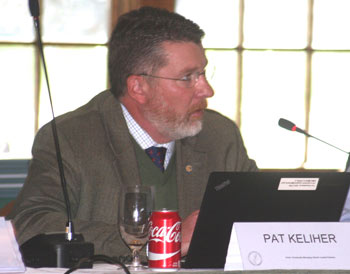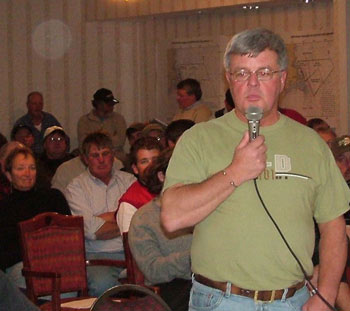Zone B Trap War
continued from Homepage

“I understand what the concern is. The concern is real. I would say in the last three years, I’ve heard it much louder every year. The question is, how to deal with it?” – Pat Kaliher, DMR Commissioner. Laurie Schreiber photo
that right….There are so many Zone C tags coming across the line now, largely due to the fact that they’ve issued so many licenses.”
The number of Zone C tags in Zone B is “shocking,” he said. “And the capacity to expand is unlimited….without some kind of legislation.”
The law currently allows fishermen to fish 51 percent of their traps in the primary zone, and 49 percent in a second zone. The 51/49 rule exists in the Zone B/C and Zone F/G interface.
The council considered several ways to address the situation: change the 51/49 ratio to 80/20; limit the right of new fishermen to fish over the line; or have an equal exchange of tags between zones.
Most or all of the Zone C effort is going on along the Zone B/C line, council members agreed.
Hilton Turner, chairman of Zone C, said he’s heard from many Zone C fishermen who have said they buy Zone B tags but don’t actually fish them.
“It isn’t everybody who comes over,” Turner said.
Turner noted he’s worked the past 10 years trying to get Zone C closed. “Yes, we have a lot of people fishing there,” he said.
“Because there were too many licenses being issued,” responded Horner.
“Yes,” said Turner.
“That’s why they spilled over into B,” said Horner.
“That’s right,” said Turner.
Fisherman Jon Carter said that, when it was set up, the double-tagging system should have incorporated a historical participation element, with a control date.
“These people who are coming over the line now, there’s no historical participation,” said Carter. “Back years ago, when they came up with 49/51 percent, there was some historical participation: People did go back and forth….If we had gone to historical participation way back then we would have been able to deal with this problem a lot sooner.”
A Swan’s Island fisherman said he’s had to pull back his traps from upper Blue Hill Bay because of overcrowding. And, he said, he’s not fishing the way he’d like to because he fears his traps being cut.
“I understand what the concern is,” said Department of Marine Resources (DMR) Commissioner Pat Keliher. “The concern is real….I would say in the last three years, I’ve heard it much louder every year.….The question is, how to deal with it?”
Many on the council and in the audience agreed that an equal exchange of tags every year could solve the problem, with Zone B given a discretionary say over the number of tags.
Keliher said he didn’t have the authority to deal with tags in that way. It would have to be a law, he said. But, he added, if the suggestion is to give a zone council “additional authority that allows them to put something in place that impacts the neighboring zone, I don’t think it would be looked at very positively.”

There’s been hundreds of thousands of dollars of losses to individuals who were fishing in their backyard who are being driven out by people who aren’t in their backyard. – Jon Carter, Bar Harbor Fishermen's Voice photo
But one fisherman said that kind of impact already occurred with Zone C being left open—a decision that impacted Zone B.
According to DMR numbers, in 2015, 156 Zone C fishermen bought about 52,000 Zone B tags, and 55 Zone B and 29 Swan’s Island fishermen bought about 14,800 Zone C tags.
“It’s got to move some direction,” said one fisherman. “If this doesn’t pass, I don’t know where we’ll be. We’re losing so much ground every year….We can’t even come close to the C line anymore.”
“There’s been hundreds of thousands of dollars of losses to individuals who were fishing in their backyard who are being driven out by people who aren’t in their backyard,” said Carter, speaking of trap cutting on the Zone B side of the line. According to the DMR, trap-cutting has been going on since early summer but escalated in the fall. In an Oct. 31 DMR press release, Marine Patrol Colonel Jon Cornish said, “This trap war is without a doubt the most costly loss of gear I have witnessed in my 32-year career with the Maine Marine Patrol.” In an incident at the time, gear loss was estimated to exceed $350,000.
Seventeen Swan’s Island fishermen sent an email to the council that said, “We have seen the presence of Zone C fishermen in Zone B waters go from nonexistent to almost uncountable.” Swan’s Island fishermen have been dealing with the problem for many years, the email said. “If nothing is done, we believe that what we have lived in 2016 will just be a much larger problem in 2017. Nobody wants to have to live through that again.”
On another matter, the council considered options for the administration of a waiting list for fishermen who wish to transfer from one zone into another zone.
Last April, the state legislature passed LD 1503, An Act to Amend Lobster and Crab Fishing License Laws, which created a transfer waiting list that will be separate from the apprentice waiting list. According to DMR information, at present, all individuals who wish to enter a limited entry zone are placed on a single waiting list for that zone. This includes individuals who have completed the apprenticeship program and wish to obtain their first commercial license, as well as current license-holders who wish to transfer from one zone to another. The new law will allow existing license-holders to be on a separate transfer list, which will presumably move more quickly than the apprentice waiting list.
The question was, how would transfers be allowed. Two proposals under consideration included:
• Create a single transfer list. Each year, when new zone entry is calculated, DMR would go down the transfer list and determine if there are any matches—for example, there is a fisherman who wants to transfer from Zone A to Zone B, and a fisherman who wants to transfer from Zone B to Zone A. DMR would authorize the swap. The advantage of that proposal would include making transfers one-to-one, thereby not resulting in any net increase in fishermen per zone. The disadvantage is that, if there is no corresponding fisherman who wants to move in the opposite direction, some transfers might never be allowed.
• Calculate new zone entrants for each year, and allow a certain number of transfers for every new zone entrant—for example, one transfer per five, or some other number, new zone entrants off the apprentice waiting list. The advantage would be that this would ensure some movement of the transfer list. The disadvantage is it would cause minimal additnal entry into the zone beyond new zone entrants.
One fisherman said, whatever, the strategy, it must ensure that people on the apprentice waiting list don’t lose out.
Currently, nearly a dozen fishermen want to transfer into Zone B. Many are currently in Zone C.
Council members said the arrangement should include landings or trap-equivalency criteria so that, for example, someone who fishes 800 traps transfers into Zone B while a Zone B fisherman who fishes 50 traps transfers out.
“My goal in developing this is keep it simple so it’s not a burdensome process but still fair,” said Keliher.
Keliher said the consensus of the zones is the one-to-one transfer, although many have also said they don’t like the transfer list idea at all. Overall, he said, the major concern is to keep the apprentice waiting lists moving.
